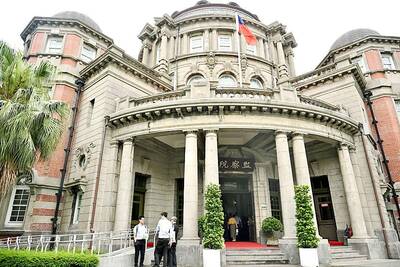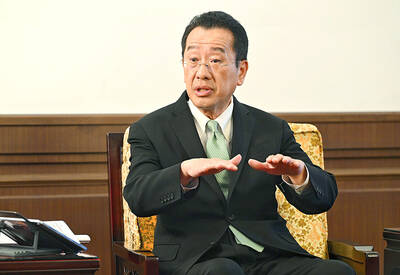Russ Root made an efficient move last year -- to a new home he had built in Goshen, Connecticut. While it is considerably bigger than his former house, in Chenango Forks, New York, it will cost far less to cool and to heat. That is because he did something he had thought about ever since he built his last house, 15 years earlier: He installed a geothermal system instead of an oil-guzzling boiler.
Now all the heat to warm his house is supplied by the earth beneath him. It's pumped up, through plastic piping, in water circulating in his backyard 1.8m underground -- where the temperature stays at about 45o -- and distributed by a fan through the house's ductwork as air warmed to around 95o.
The bill for Root's geothermal pump, its ground loop of piping and the house's ductwork was just over US$21,500. While a geothermal system, including labor, typically costs more than a comparable furnace and air-conditioning system, the price was about the same for Root, because the extra expense of digging and looping -- US$1,500 in his case -- was more than offset by a US$2,000 rebate from Connecticut Light and Power.

PHOTO: NY TIMES NEWS SERVICE
"I was in the black from the day I moved in," Root said, who is a lineman for the utility, which treated him as it would any other customer.
The water circulates through the geothermal pump over coils containing refrigerant, which absorbs its heat. The refrigerant is then raised to the higher temperature under pressure by a compressor. In the summer, the method is reversed. His home is cooled by circulating hot air out of the house -- a process that is similar to the operation of a refrigerator, an appliance that his basement pump resembles.
The system is quiet, clean and odorless, and uses little electricity. Maintenance consists of cleaning a filter every few months; the pipes are guaranteed to last 50 years. There are virtually no moving parts other than the pump. After living for more than a year in the 269.5m2 home, a third bigger than his old house, Root finds that his energy costs are running about 20 percent less than the US$2,700 he used to spend.
And he is likely to reap added benefits when he sells the house. A 1998 study commissioned by the Environmental Protection Agency found that a home's value rises an average of US$20 for each US$1 decrease in the annual utility bill.
Although the notion of tapping the earth's heat has been around forever and the basic technology has existed for decades, the many advantages have only recently begun to win widespread attention. The big reasons are concern for the environment and, more to the point, money. Geothermal systems are becoming increasingly competitive, even for homes in which an old furnace and air-conditioning system must first be removed.
After a decade in which installations grew 20 percent a year, a million American homes -- both old and new -- now have geothermal heat pumps, said Jessica Commins, a spokeswoman for the Geothermal Heat Pump Consortium. And a growing number of celebrity homeowners who use them -- like the country music star Toby Keith, the Home Depot co-founder Arthur Blank, the actor Ed Begley Jr. and President George W. Bush -- have helped to raise the technology's profile.
Energy legislation last summer increased the financial support for these systems. The law provides for US$300 in federal tax incentives and includes a provision allowing for a US$2,000 federal incentive for home improvements that reduce energy costs by more than 50 percent. Geothermal systems can trim 30 percent to 75 percent of the cost to heat and cool, so many installations would qualify.
But the biggest driver is the cost of fossil fuel. With the Energy Department predicting huge jumps in residential oil and natural gas costs for winter heating -- 27 percent for oil and 41 percent for gas -- shipments of geothermal pumps doubled during the last three months, Commins said.
Now, "the front-end costs are within reach," Roy Mink, director of the Energy Department's geothermal program said. At the same time, "there's more competition for geothermal business, and that's driving down the price of installing them by 10 percent," he said.
The payback period depends on a variety of factors, including the type of system, the installer and the location and size of the house. Typically, it takes three to 10 years before fuel savings equal the cost of the pipes and placing them in the ground; indoors, the cost of traditional and geothermal systems is roughly the same. Of course, the greater the heating and cooling needs and the higher the fuel costs, the quicker the payback. A 232m2 home in New York City with a standard furnace and central air costs US$3,200 a year, on average, for heating, cooling and hot water, versus US$1,800 for a geothermal system; in Los Angeles, the figures are US$1,600 and US$800.
Installers generally stick to one brand of pump to get better pricing from the manufacturer, so the installer and pump tend to be a package deal. The standard for installers is certification by the International Ground Source Heat Pump Association; the most desirable pumps carry an Energy Star efficiency rating. Among the brands earning that rating are WaterFurnace, Climate Master, Trane, HydroDelta, McQuay and Econar.
"Water Furnace is the Cadillac," Steve Brown, co-owner of Carl Franklin Homes in Dallas, a builder of homes with geothermal systems, said. "But there are a lot of good pumps, and it's more important who puts in the system. You have to shop around to get the best deal."
Installers generally recommend three types of systems: those with horizontal, open vertical and closed vertical loops. A horizontal loop system, typically an E-formation that requires about a half-acre, is recommended when homeowners have the space, as Root did. It is generally the least expensive, and its costs fall further if it is part of new construction, because its installation can be combined with the laying of the foundation.
The cost of a loop varies greatly, from about US$1,000 for a horizontal loop connected to a modest house in the West, where geothermal systems are more common and homeowners have more options, to US$50,000 or more for a vertical closed loop attached to a mansion atop New England bedrock.
A vertical loop, generally two or more connected branches extending more than 60m into the ground, is the urban choice; it requires less surface area but is likely to cost more because of the drilling expense.
There are also open vertical systems, which are drilled in much the same way as a water well and may be used when there is access to an aquifer. These may do double duty in rural areas by providing homes with drinking water.
Steve Toma has an open system in his new 650m2 home in Mendham, New Jersey, that taps a well 427m down. Because of its unusual depth, it was expensive to drill. He also has extras like filtration equipment and a radiant-heat grid, which add significantly to the cost. His system cost more than US$135,000, roughly 30 percent more than an equivalent traditional oil or natural gas installation; he expects to earn back the difference in about eight years.
"It's a big investment, but there's the green aspect," he said. "You can't put a dollar on it."
For a relatively few lucky homeowners, there is an option that delivers the best of both green worlds. It's the pond loop, for homes near a body of water that is at least 2.4m deep year-round. There are no digging or drilling costs, just the cost of a Slinky-like tubing coil and the labor of placing it at the bottom of the pond or lake.
"It's generally the cheapest," Kirk Bellanca said, a co-owner of Enviro-Tech, an installer in Staatsburg, New York "You should get permission from the town, but they're almost always very supportive. The fish like it, too. It becomes part of their habitat."
In a sense, two comfortable homes for the price of one.

GAINING STEAM: The scheme initially failed to gather much attention, with only 188 cards issued in its first year, but gained popularity amid the COVID-19 pandemic Applications for the Employment Gold Card have increased in the past few years, with the card having been issued to a total of 13,191 people from 101 countries since its introduction in 2018, the National Development Council (NDC) said yesterday. Those who have received the card have included celebrities, such as former NBA star Dwight Howard and Australian-South Korean cheerleader Dahye Lee, the NDC said. The four-in-one Employment Gold Card combines a work permit, resident visa, Alien Resident Certificate (ARC) and re-entry permit. It was first introduced in February 2018 through the Act Governing Recruitment and Employment of Foreign Professionals (外國專業人才延攬及雇用法),

WARNING: From Jan. 1 last year to the end of last month, 89 Taiwanese have gone missing or been detained in China, the MAC said, urging people to carefully consider travel to China Lax enforcement had made virtually moot regulations banning civil servants from making unauthorized visits to China, the Control Yuan said yesterday. Several agencies allowed personnel to travel to China after they submitted explanations for the trip written using artificial intelligence or provided no reason at all, the Control Yuan said in a statement, following an investigation headed by Control Yuan member Lin Wen-cheng (林文程). The probe identified 318 civil servants who traveled to China without permission in the past 10 years, but the true number could be close to 1,000, the Control Yuan said. The public employees investigated were not engaged in national

The zero emissions ship Porrima P111 was launched yesterday in Kaohsiung, showcasing the nation’s advancement in green technology, city Mayor Chen Chi-mai (陳其邁) said. The nation last year acquired the Swiss-owned vessel, formerly known as Turanor PlanetSolar, in a bid to boost Taiwan’s technology sector, as well as ecotourism in Palau, Chen said at the ship’s launch ceremony at Singda Harbor. Palauan President Surangel Whipps Jr and Minister of Foreign Affairs Lin Chia-lung (林佳龍) also attended the event. The original vessel was the first solar-powered ship to circumnavigate the globe in a voyage from 2010 to 2012. Taiwan-based Porrima Inc (保利馬) installed upgrades with

ENHANCE DETERRENCE: Taiwan has to display ‘fierce resolve’ to defend itself for China to understand that the costs of war outweigh potential gains, Koo said Taiwan’s armed forces must reach a high level of combat readiness by 2027 to effectively deter a potential Chinese invasion, Minister of National Defense Wellington Koo (顧立雄) said in an interview with the Chinese-language Liberty Times (sister newspaper of the Taipei Times) published yesterday. His comments came three days after US Secretary of State Marco Rubio told the US Senate that deterring a Chinese attack on Taiwan requires making a conflict “cost more than what it’s worth.” Rubio made the remarks in response to a question about US policy on Taiwan’s defense from Republican Senator John Cornyn, who said that Chinese